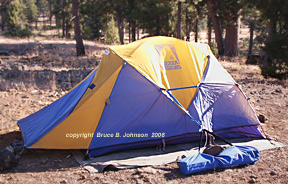 History of Gear:
A Small but mighty Geodesic Tent
History of Gear:
A Small but mighty Geodesic Tent History of Gear:
A Small but mighty Geodesic Tent
History of Gear:
A Small but mighty Geodesic TentAccording to Bob Howe, tent designer, the Sierra Designs "Tiros" geodesic tent is one of the select few that he would trust his safety to for a hard-core expedition to the Himalayas. Pictured is my personal Tiros, one of the earlier models, produced around 1991, and designed by tent designer Martin Zemitis (and also named by him, after the "Tiros I" weather satellite put up by the US in 1960, considered the first successful weather satellite in history).....
When one sets up the
Tiros' inner tent, they are immediately impressed with the tautness
of the resulting structure. The tent surface is marked by small,
tightly-strung "panes." 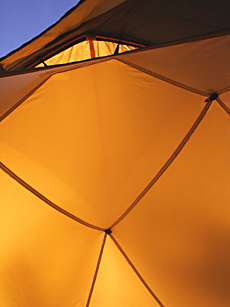 Pushing
on the peak as if you were a mighty wind or a heavy load of wet
snow produces only a reassuring resistance. In actual use, the
tent seems like a smaller, more compact version of the original,
super-strong North Face
"Oval Intention." In
heavy winds, the Tiros just sits tight, creaking a bit from the
heavy gusts, with no disconcerting flapping/cracking noises. It's
been tested by Sierra Designs test teams near the 14,200 ft. summit
of California's Mt. Shasta, and also on the summit of Mt. Washington,
New Hampshire, where it stood up admirably to winds up to a measured
96 mph, and still standing after four days of winds peaking that
high. . You can find videos on Youtube about those tests; eg.
on the website of Martin Zemitis' "SlingFin" tent company
(www.SlingFin.com)
Pushing
on the peak as if you were a mighty wind or a heavy load of wet
snow produces only a reassuring resistance. In actual use, the
tent seems like a smaller, more compact version of the original,
super-strong North Face
"Oval Intention." In
heavy winds, the Tiros just sits tight, creaking a bit from the
heavy gusts, with no disconcerting flapping/cracking noises. It's
been tested by Sierra Designs test teams near the 14,200 ft. summit
of California's Mt. Shasta, and also on the summit of Mt. Washington,
New Hampshire, where it stood up admirably to winds up to a measured
96 mph, and still standing after four days of winds peaking that
high. . You can find videos on Youtube about those tests; eg.
on the website of Martin Zemitis' "SlingFin" tent company
(www.SlingFin.com) 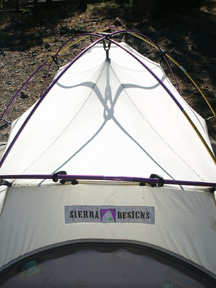
The Tiros is a wonderful tent, and its fly is also wonderfully designed, adding a great vestibule which can be placed over either the front or back door. The fly clips on easily, and is provided with numerous points from which the tent can be securely guyed to withstand that Himalayan blizzard.
Please
Note: All Material below, and in all my "History
of Gear" webpages, is copyrighted, and no usage of my material
is permitted unless explicit permission is granted by me, Bruce
B. Johnson, owner of OregonPhotos.com. Some of the material below
is derived from interviews and/or correspondence with Bob Howe
and Martin Zemitis, tent designers, as well as my own research......Gear Lovers: if you were involved with one of the old-line,
vintage gear companies and have a story to tell in these pages,
please contact
me soon at: brucej@Oregonphotos.com
Those who have lived
through a severe windstorm high above timberline in a conventional
A-framed mountain tent, even the best of them by the best manufacturers,
do not wish to relive the experience. Such users take one good
look at the features of the Tiros and immediately realize its
genius. . Below is a view of the Tiros without its rainfly....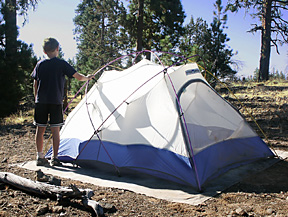 Check out my story
about surviving
a high mountain windstorm below.
Check out my story
about surviving
a high mountain windstorm below.
Specs on the Tiros: Weight a modest 7 pounds. Four Poles, attaching to the tent body through grommets at bottom and Sierra Designs "Swift Clips" along the canopy.... The stout poles are of a heavier than normal guage, contributing to the Tiros' uncommon stregth. An internal guying system could be purchased as an option and added even more strength to the tent, especially in term of high winds.
The geodesic design means that the tent is free-standing, and can be picked up and moved to a better location, or picked up and shaken like a rag to remove stubborn snow and ice. In fact, the Tiros' geodesic design is so self-supporting that the frame alone will stand up without being clipped to the canopy! (see picture below). You will note that the poles still require being anchored in their bottom grommets to achieve this, but that does lead the innovative backpacker to imagine creating webbing straps with grommets to anchor the poles, and then to carry only the rainfly, thus achieving a roomy, and lighter tent for those go-light expeditions. Please contact me if you ever try this and I will post your results! Bob Howe tells me that when he worked at The North Face many years ago he was involved in creating the first "footprints," which then evolved into footprints with poles and fly for use as lightweight shelters. Now many manufacturers have caught on, and offer their versions of "minimalist shelters." For example, the popular REI Half-Dome 2 HC tent offers a "footprint" sheet with grommets for the poles to allow such a use.
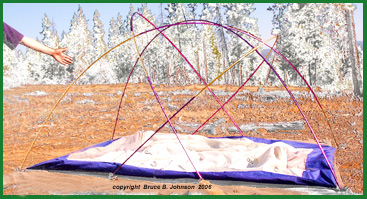
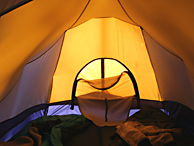
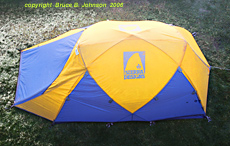
We weren't very high on Mt. Shasta when failing daylight decreed that "here" was where we would pitch the tents and set up camp. My altimeter read 9,600 feet on that early May evening, a clean, clear sky above gave us high hopes for success on our planned climb of the 14,000 foot peak. We scurried to get our orange 3 man REI "McKinley" tent up and anchored before darkness. Numb fingers began to be a problem, but we were almost done, and so I took a break to check the thermomether set out atop my pack. 14 degrees it said; I was astounded, it had dropped 15 degrees in just 35 minutes! We were in for a very cold night!
The three of us had a quick meal of hot oatmeal and some tea, and went to bed. With winter-weight down bags and our reputedly expedition-proven "McKinley" tent, we felt secure, even though by now it was 9 degrees outside, with piercing cold matching the piercing stars.
Sleep came quickly, but sometime in the middle of the night we were startled awake by the sounds of a mighty wind that was swirling and tearing at the mountain's hard-frozen sides. Gusts like giant's hands pummeled and shook our tent. The two ends of the tent were repeatedly pushed violently toward one another, and then released with explosive sounds, and a constant undercurrent of wild generalized flapping worried at our nerves. There was nothing, nothing at all any of us could think of to do, and it was difficult to talk or think in the tumult. We just curled up to wait, hoping the windstorm might subside as suddenly as it had come. Somehow, eventually, I fell into a fitful sleep.
Bright light seemed all around me, I was momentarily confused, but then realized morning had come, and the wild cracking and pounding of the tent had ended. I felt relief, but then knew that something was quite wrong when I pushed my head out of my bag and saw only orange, very close up orange, orange nylon draped right over my face. With a start, it was all clear, the tent was DOWN on top of us!
As we struggled free of our bags and then free of the tangled mess of the tent, we knew we were in trouble. The bar-tacked attachment points of the hooped metal frame had ripped out from the canopy at several points, and it was dismally obvious that the tent wasn't going to be field-repairable. Could we go on with our climb, and use the tent as an oversize bivy sack? Maybe, but an unrelenting 20-30 mph wind tore at us from out of the pure blue sky. Our thinking seemed slow and decisions came with difficulty. My thermometer had risen to only 16 degrees at 10am, and at that point all three of us seemed to reach the same conclusion with really no discussion. We stuffed the broken tent into our packs and headed rapidly downhill to our car far below. That tent never got repaired and was replaced by a mountaineering A-frame like the REI Crestline, judged to a design which possessed a far stronger method of attaching poles to tent canopy.
Copyright Bruce B. Johnson 2006-2024, All Rights Reserved.